
1. Introduction
The document below is a comparison of Egnyte and DriveHQ by top experts in the cloud service industry. Their expertise, insights and hands-on business experience open up a very different perspective. Whether you are an Egnyte fan, DriveHQ fan or an independent tech editor, reading the document below will help you better understand the strengths and weaknesses of Egnyte and DriveHQ, as well as the business cloud service requirements and solutions.
2. Summary
Egnyte claims to be a business-class online solution that eliminates the costs and complexity of purchasing and maintaining traditional file servers, tape backups, FTP and VPN systems. In this review we will compare Egnyte’s solution with DriveHQ’s solution, incl. features, prices, infrastructure requirements and more.
2.1 Cost Comparison
From any point of view, Egnyte’s price is undoubtedly one of the most expensive. When you consider the type of service being provided the price is even more astounding! For 30 users with 2TB storage space and 5GB max file size, the price ranges from a minimum $5400/year to $9179.88 (or even higher if you add more options).

For enterprise services, it charges $180/user/year for the base service. That price only includes 2TB of storage space for all users, and does not include certain advanced features. The total cost can go as high as $350/user/year, which is many times higher than DriveHQ’s, and significantly higher than Google Drive or even Dropbox.
For its price, any claim of “eliminating the costs of traditional file server, FTP and VPN systems” is pointless, as Egnyte’s cost is more expensive than traditional solutions. Though Egnyte does not eliminate traditional IT systems; in fact, its “hybrid” system requires local IT infrastructure. Thus Egnyte will simply increase cost and complexity as opposed to making life easier.
2.4 You cannot share files with non-Egnyte members. You can only share files with Egnyte members in your own group account.
Egnyte does not offer free service. You cannot share files with an external client who is not an Egnyte member. Since most of your clients are non-Egnyte members, lacking of this feature means you cannot share files with your external clients. What’s worse, you can only share files with your own group members. DriveHQ and many other cloud storage services support sharing files with non-members, and users that don’t belong to the same group account.
2.2 Egnyte’s main selling points
Egnyte marketed its service with some interesting terms such as “local cloud” and “hybrid cloud.” For less tech-savvy people, it might appear as some unique or advanced technology. In reality, Egnyte’s “Local Cloud” is merely a synchronized folder, just like Dropbox. So what is Egnyte’s “Hybrid Cloud?” Egnyte’s own explanation is that it “combines the speed and security of local storage with the accessibility of the cloud.”

In fact, it is still the same synchronization solution, where you synchronize a cloud folder with a local storage on a server or storage appliance. Based on Egnyte’s definition, any synchronization solution is hybrid because you can access the files on the local storage device, or in the cloud (so any provider offering synchronization is “hybrid”).
2.3 What makes Egnyte different
Egnyte has repositioned itself as offering “Enterprise File Sharing” service that includes file access, sharing, collaboration and large file transfers:
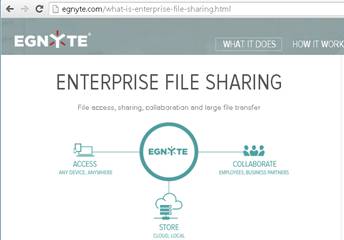
More specifically, Egnyte claims to solve the following problems: “cloud file sharing, private file sharing, local file access and cross-office collaboration,” and that it makes Egnyte’s service different from others. In reality, none of these features are new. DriveHQ and many other cloud storage providers had such features before Egnyte. Moreover, DriveHQ offers many other business features that are not available on Egnyte, e.g.: file sharing via “true” drop box folder; file hosting and publishing; web hosting, automatic online backup, etc.
2.5 Egnyte’s real services and weaknesses
2.5.1 Egnyte’s real service is still mainly the same folder synchronization service and online storage service.
While Egnyte wants to position its service as being different from other cloud storage services, in reality, Egnyte’s main service is still a Folder Synchronization service. The differences are very minor: Instead of synchronizing a folder on all computers, Egnyte uses a local file server or storage system to synchronize with the files on the cloud. Users in the same office will access the local file server / storage system directly without having to access the cloud. This can achieve much faster performance as most users will access local files only. However, such solution is not unique to Egnyte. Any synchronization service can be configured this way. And it does not solve the problem of working from home, hotel or any other remote locations.
2.5.2 Egnyte lacks Explorer-like File Manager software to handle huge amount of data
Well-designed Explorer-like File Manager software can handle any amount of data. However, Egnyte’s Local Cloud (Folder Sync) software cannot. Can you really sync 100GB or 1TB of data to multiple computers and mobile devices? Such a task could not be achieved with Egnyte. Egnyte’s software will use more and more RAM and CPU as your number of files increase, and it will take a very long time to sync so much data on multiple computers. In the end, you will waste a lot of bandwidth and disk space on each computer.
3. Detailed Reviews and Comparisons
In the summary section, we have talked about “local cloud” and “hybrid cloud.” We know they are really just regular folder synchronization, and folder synchronization using a local file server / storage system. Egnyte’s service is very much like Box or Google Drive, thus the comparison is very similar to Box’s and Google Drive’s. Egnyte’s service mainly includes web browser based cloud storage and sharing, and Egnyte Local Cloud (Folder Sync) client software.
3.1 Web browser-based cloud storage cannot scale to large files and folders.
While it is convenient accessing a few cloud files from a web browser, web browsers are not optimized for uploading/downloading large files and folders. If a folder has over 5,000 files, it is very hard to access files in it. Enterprises often have folders with tens of thousands of files, making it virtually unusable with a web browser. Egnyte does not have an explorer-like File Manager client. DriveHQ has File Manager client which can manage any number of files and folders.
3.2 Egnyte.com website lacks some basic online storage features.
Compared with DriveHQ.com website, Egnyte’s website seems to be cleaner. However, it is missing some basic features. E.g: As you can see from the screenshot below:
Egnyte’s website lacks fundamental features like Cut, Copy and Paste that are available on DriveHQ website.
Even on a modern web browser such as IE 10+ and Chrome, Egnyte website does not support drag and drop files/folders from one cloud folder to another cloud folder;
It does not support right click on a folder or file to open customized menu (Egnyte just uses browser’s default right click menu, which is not relevant to the cloud storage service).
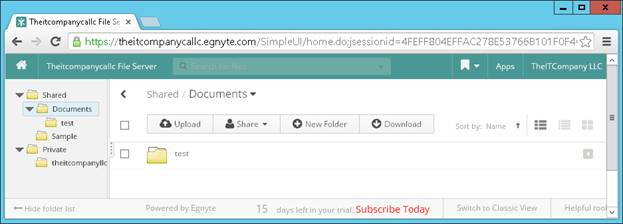
More strangely, Egnyte does not display a folder’s create time, modify time and size. Please see the screenshot below. There is no property pages or detail pages to show the folder time and size.

Compared with Windows Explorer and Mac Finder, Egnyte’s website does not display column headers in the file / folder list, making sorting files and folders significantly harder.
3.3 Egnyte’s folder sharing has many design flaws or weaknesses compared with DriveHQ’s.
3.3.1 First, all folders shared by all users are mixed together in the virtual folder “Shared”.
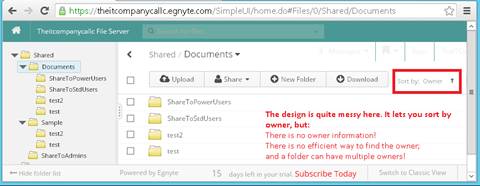
It is very hard to find the folder owners. See the screenshot below. The folder list does not display the folder owner even though it supports sorting by owner and a folder may have multiple owners. It is also very hard to find who has access to which folder until you go to the folder permissions page for each folder. As subfolders can also be set with different permissions, it is very hard to check all folders’ permissions. For an enterprise that has many users with share abilities, it is extremely hard to manage shared folders:
3.3.2 Only administrators can create a new shared folder. Even power users cannot share folders.
This will create a lot of extra work for administrators, especially in large organizations.
3.3.3 All administrators have full access to all files and folders in the entire business account.
There is no concept of the group owner (business owner) with Egnyte. All administrator users can create and delete any users, or create and delete any files / folders. For small business owners, it means either he will be the only administrator, or if he creates another administrator, his administrator will be able to access all his files/folders.
3.3.4 It does not support sub-group administrators.
With DriveHQ, you can create a sub-group admin who can create / manage sub-users in his own sub-group. With Egnyte, an administrator user will have control over all other users. While you can also create groups, it is just a set of user accounts with no sub-group administrators.
3.3.4 You cannot find a folder share date and time. (DriveHQ can)
3.3.5 You cannot set a shared folder to expire automatically. (DriveHQ can)
3.3.5 You cannot set automatic notification when somebody uploads files into a shared folder. (DriveHQ can)
3.3.6 When sharing a folder to other users, you have to type in the username for it to search. You cannot select from a list of users or groups.
3.3.7 Displaying all users’ private folders in the administrator’s account creates privacy concerns. It is also not scalable when an enterprise has thousands of users.
An enterprise may have multiple administrators. Each administrator can easily access all private folders of all users, incl. company owners and executives’ folders. Even if this is not a concern, when an enterprise has thousands of users, displaying thousands of folders in the folder tree will slow down the system, not to mention making it very hard to locate a user’s private folder.
3.4 Even at $180/user/year, Egnyte’s business plan still lacks security features like:
Event Log (audit) feature; It lacks IP Address restriction; It lacks client-side encryption: The web browser based upload / download does not support client-side encryption; The Egnyte Local Cloud also does not support client-side encryption! Lack of client-side encryption means Egnyte employees can access your sensitive information if they want to. Any hackers may also be able to access your sensitive information. You cannot even log off Egnyte Desktop Sync, nor change your username. https://helpdesk.egnyte.com/entries/21722410-How-do-I-change-the-username-for-Personal-Local-Cloud-application-
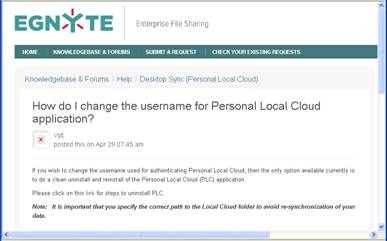
According to Egnyte support: "If you wish to change the username used for authenticating Personal Local Cloud, then the only option available currently is to do a clean uninstall and reinstall of the Personal Local Cloud (PLC) application. " While most users probably don't need to log off, not allowing people to logoff is a security bug, and it may also create unnecessary work when transferring accounts.
3.6 Compare Egnyte Desktop Sync (Local Cloud) with DriveHQ FileManager
3.6.1 Egnyte only syncs a special "Local Cloud" folder on your PC.
You do not have the ability to choose a folder (or folders) on your PC and sync with the cloud. You must move your files or folders to the special “My Box Files” folder in order for them to be synced. This means you or your employees will have to change their work habit, many employees will need to be retrained.
DriveHQ can sync any folder(s) on your computer to any folders in the cloud.
3.6.2 After you configure Egnyte Local Cloud, you cannot change the “local cloud” folder location.
By default, Local Cloud selects “C:\LocalCloud” as the local sync folder. Once it is installed, you cannot change this folder. If you don’t have enough storage in the selected drive, you will have to reconfigure the synchronization.
3.8.2 Egnyte does not support multiple sync tasks with different schedules.
The entire “Local Cloud” folder is one synchronization task. You cannot create multiple sync tasks to sync different folders using different schedules. With DriveHQ FileManager, you can sync different folders using different schedules.
3.8.3 Egnyte does not support one-way synchronization tasks.
Sometimes, you just want to push (sync) your data to the cloud and never worry about your local files being overwritten or deleted. Other times, you just want to pull (sync) data from the cloud. But with Box, you cannot, it only supports two-way sync. So any changes made from either side will affect the other. DriveHQ FileManager supports one-way folder sync (incl. both cloud-to-local and local-to-cloud)
3.8.4 Egnyte’s Local Cloud synchronization cannot exclude files / folders using wildcard characters such as “*” and “?”.
Many programs create temporary files or backup files, e.g. MS Word creates a temp file with the file name like “~$test.docx”. Many programs create intermediate files or activity log files such as *.bak, *.obj, *.log, *.tmp, etc. There is no need to sync those files; however with Box, you cannot filter those useless files. Not only does this waste precious storage space, but it will also slow down your network dramatically. With DriveHQ FileManager, you can filter certain folders/files using wildcard characters.
3.8.5 Egnyte cannot free up your local disk space.
For consumers / businesses that want to offload some files from their hard drives to the cloud and free up disk space; Egnyte will fail because it will keep a copy of the files on the local drives. Because DriveHQ offers much more advanced cloud IT service, you can free up some disk storage space by storing your files to DriveHQ's cloud file server.
3.8.6 Egnyte Local Cloud does not have upload / download task list; you cannot control upload / download tasks.
You cannot manually control the upload / download tasks; You cannot manually start / stop uploading/downloading a file; You cannot monitor the upload / download progress of each file; You cannot manually interrupt or resume an upload / download task; You cannot arrange the order of the file being uploaded / downloaded before other files. This feature can be very useful: if you need to upload 101 files with the total size of 1GB, and if one file alone is 900MB, it would take hours for all the files to upload. But if you upload the 1MB files first, then you can upload 100 files in a much shorter time and then you just have 1 file remaining to be uploaded.
3.8.7 Egnyte Desktop Sync cannot sync network drives
As you can see from the screenshot below, when you install Egnyte Local Cloud, if you select a network folder, it will report an error message: "Your Egnyte data folder is missing or not specified. Please uninstall and reinstall Personal Local Cloud."
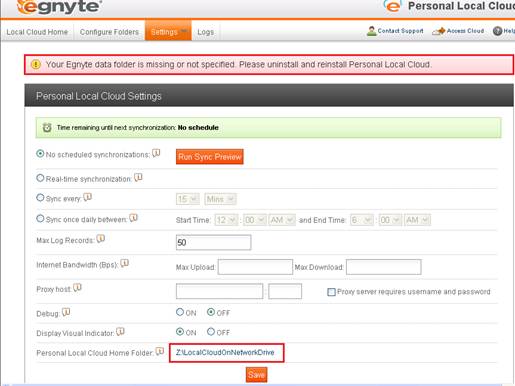
With DriveHQ FileManager, you can sync network folders or external drives.
3.8.8 Egnyte Desktop Sync cannot sync open (locked) files.
A lot of people might work on a file for days without closing it and Egnyte will not sync the file until it is saved and closed. What if you forgot to close the file? You will not be able to access the latest version remotely; and if you accidentally delete the file before you close it you will lose your file.
DriveHQ FileManager can sync locked files when you turn on the VSS (Volume Shadow Copy) feature from the “My Options” screen.
3.8.9 Egnyte Desktop Sync cannot sync Outlook PST file and Quickbooks files.
Because Egnyte Desktop Sync cannot sync open files, it cannot synchronize Outlook PST files and Quickbooks files.
3.8.10 Egnyte Desktop Sync can sync a max of 20,000 items in one folder.
Most users probably don’t have 20,000 items in one folder. However, for enterprise use, you are bound to have a user with excessive folder size.
3.8.11 Oddly, Egnyte Desktop Sync software is browser-based. It is not as functional and efficient as native applications.
After you install Egnyte Desktop Sync client, you may notice that your computer become slower as Egnyte will start 4 processes when it is idle. It will have 5 processes when it is actively synchronizing.
Egnyte recommends users to have at least 4GB RAM, and runs Windows 7 and Windows 8 only. See the link below:
Helpdesk.egnyte/entries
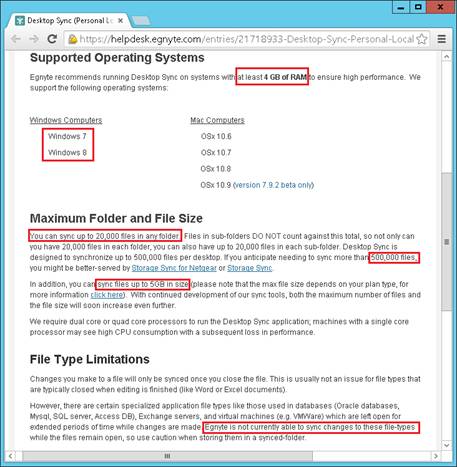 Most Windows 8 based tablets and networks will be underpowered to run Egnyte desktop sync.
Egnyte installs a local web server (likely to be some open source web server) to interface with the web browser and the cloud. Therefore it is at least 50% less efficient in terms of memory usage, CPU and communication overhead than DriveHQ FileManager. The screenshots below show the memory usage when Egnyte Desktop Sync is idle and when it is synchronizing.
Most Windows 8 based tablets and networks will be underpowered to run Egnyte desktop sync.
Egnyte installs a local web server (likely to be some open source web server) to interface with the web browser and the cloud. Therefore it is at least 50% less efficient in terms of memory usage, CPU and communication overhead than DriveHQ FileManager. The screenshots below show the memory usage when Egnyte Desktop Sync is idle and when it is synchronizing.
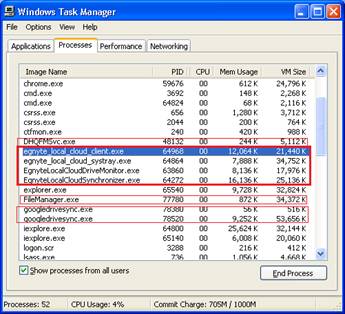 Egnyte Desktop Sync processes and memory usage when idle
Egnyte Desktop Sync processes and memory usage when idle
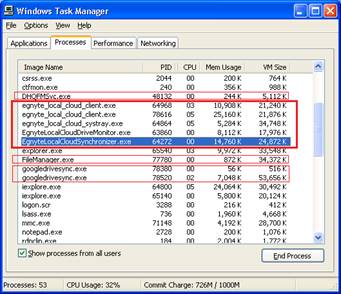 Egnyte Desktop Sync processes and memory usage when syncing the same test data
Egnyte Desktop Sync processes and memory usage when syncing the same test data
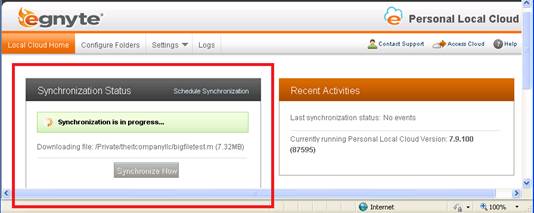
3.8.12 Egnyte Desktop Sync's progress screen displays the least amount of information among all sync software we had reviewed.
It does not even have a progress bar. You cannot find the transfer speed, the total amount of data, the percentage transferred or the remaining time. See the screenshot below.
3.8.12 Egnyte Desktop Sync cannot stop or pause a sync task
Egnyte Desktop Sync's browser-based interface cannot stop or pause the sync task. Also, if you temporarily don’t want to sync a folder by de-selecting it from the “Configure Folders” screen, Egnyte Local Cloud will actually delete the folder from your local computer.
3.9 Egnyte has limited support for WebDAV and FTP
3.9.1 Compared with DriveHQ, Egnyte's Drive Mapping service is weak.
It is only available to admin users and power users, but not to standard users.
It does not support drive mapping on Windows XP (it is unclear if it supports Windows Vista).
It is supported on Windows 7 and Windows 8. But Egnyte's drive mapping has many issues that require a lot of Windows registry hacks to work around, e.g.: search on Egnyte's support pages,
you can easily find the following
Unable to save (overwrite) Word doc created on Egnyte mapped drive
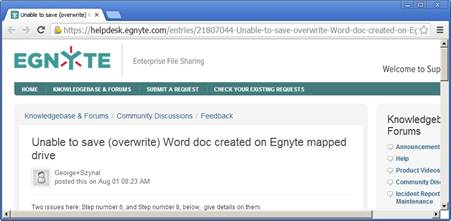 Error message 0x80070043 - the network name cannot be found while setting up Mapped drive/Prompt for User name and password does not come up
Error message 0x80070043 - the network name cannot be found while setting up Mapped drive/Prompt for User name and password does not come up
 When attempting to copy to / from Map Drive location, Error 0x80070780: The file cannot be accessed by the system.
When attempting to copy to / from Map Drive location, Error 0x80070780: The file cannot be accessed by the system.
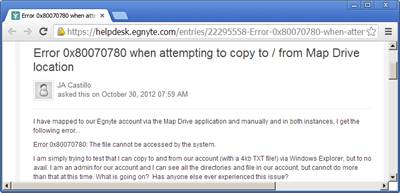 It is also very easy to run into this problem:
It is also very easy to run into this problem:
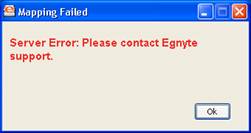 DriveHQ has offered WebDAV Drive Mapping service since 2005. We understand that regular WebDAV solution is very inefficient and unreliable. DriveHQ has since launched a newer version Enterprise WebDAV Solution, which is far more efficient and reliable than any regular WebDAV solution.
DriveHQ has offered WebDAV Drive Mapping service since 2005. We understand that regular WebDAV solution is very inefficient and unreliable. DriveHQ has since launched a newer version Enterprise WebDAV Solution, which is far more efficient and reliable than any regular WebDAV solution.
3.9.2 Compared with DriveHQ, Egnyte's FTP service is also weak
Egnyte's FTP service is also limited: It is available only to admin users and power users, but not to standard users; It does not support anonymous FTP; It limits the max concurrent FTP connections to only 3, which is for light use only.

Also, Egnyte recommends using FTP to upload large amount of data or files larger than 1GB:

In particular, Egnyte claims "We recommend using FTP if you are initially migrating up to 100GB of data or if you are uploading files that are each larger than 1 GB. It's possible to upload up to 100 GB of data in one session via FTP, but to optimize performance we recommend that you only upload 10 GB worth of files at a time."
With DriveHQ FTP, you can have far more concurrent connections, and you are not limited with the amount of data or file size.
Even better, you can use DriveHQ FileManager or DriveHQ Online Backup to transfer any amount of data. Both FileManager and Online Backup can compress data for much faster transfer speed than any regular FTP client.
3.9.3 Using Drive Mapping or FTP negatesEgnyte's value proposition.
Egnyte's main selling point is the local cloud / hybrid cloud service. Using Drive Mapping or FTP means users will directly access the cloud storage. Thus, it negates Egnyte's value proposition. Besides, why would a customer pay $180/year/user for a basic FTP hosting or WebDAV drive mapping service? It really should be less than $6/user/year.
3.10 Egnyte lacks enterprise scalability
While Egnyte claims to offer enterprise service, in reality its service can hardly scale to large enterprises.
3.10.1 The user and storage hierarchy design is flawed and not scalable.
Egnyte only supports 3 different user types: Admin user, power user and standard user. It does not support sub-group administrators. User administration will be extremely hard when an enterprise needs thousands of users. Each admin user has full control and access to all users and their files, it creates security and privacy issues, esp. such admin user can also access business owner and senior executives’ accounts and files. To put all users private files in the same "Private" virtual folder affects the scalability. It will be extremely hard to access these folders when an enterprise has thousands of users. To put all shared folders (from all users) in the same "shared" root folder affects the scalability and manageability.
3.10.2 Limiting 20,000 items in a folder is often not enough for enterprise customers
While most users don't have 20,000 files in one folder, and enterprise is bound to have a folder with excessive size. https://helpdesk.egnyte.com/entries/21272248-Remove-arbitrary-file-size-number-limits-on-syncing

According to the user's message, Egnyte might limit 600 subfolders in a folder?
3.10.3 The maximum file size limit is too small for enterprises
Egnyte Office Plan is limited to 2.5GB, for business plan, it is limited to 5GB; for enterprise plans, it is limited to 10GB. While most users probably don't have very large files, enterprises usually have much larger files, e.g. Outlook PST files, Database files, VHD files and video files that can be as large as 11GB to 200GB!

3.10.4 Active Directory integration is offered through a 3rd party at additional cost
Egnyte uses Onelogin's service for Active Directory integration. Onelogin service is not completely free. It charges $5/user/month for enterprise customers! Involving a 3rd party company for such important account security feature may increase the security risks and affect the system reliability as the 3rd party service’s security and reliability will also affect Egnyte's service. DriveHQ natively supports Active Directory integration and SSO.
3.10.5 Egnyte service cannot scale to other enterprise cloud services
Egnyte does not support other cloud features such as automatic online backup, email hosting, web hosting, Outlook email backup and true drop box folder; and it only offers limited WebDAV drive mapping and FTP hosting services. Enterprises often need more than just one cloud service. If they need more than cloud storage and sharing service, they would have to sign up for a different service from a different vendor. DriveHQ offers a one-stop shop for all core IT services.
3.11 Egnyte’s other solution is unnecessarily complicated as it requires to be deployed as a VMware virtual appliance or requires specific brand storage device (such as EMC, NetApp or Netgear, etc.)
In reality, a cloud-based service, or even a hybrid cloud service does not need to be so complicated (and expensive). It should work with any storage device, and it really does not need VMWare. DriveHQ only requires installing DriveHQ FileManager client software on a server or even a PC. It works with any server and any storage device.
4. What Other People Are Saying About Egnyte
There are some very unhappy customers. Having unhappy customers in itself does not tell much. But it’s interesting to see why they are so unhappy:
http://community.spiceworks.com/product/3546-egnyte
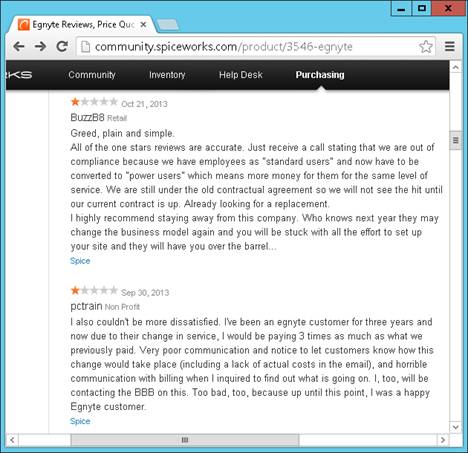 Reading user’s complaints, we see that Egnyte tried different ways of forcing their existing customers to pay a higher price. Over the last few years, they have also hiked their prices dramatically. Moreover, they actually hiked existing customer’s service price by 3 times with little communication (see images).
Reading user’s complaints, we see that Egnyte tried different ways of forcing their existing customers to pay a higher price. Over the last few years, they have also hiked their prices dramatically. Moreover, they actually hiked existing customer’s service price by 3 times with little communication (see images).
5. Appendix
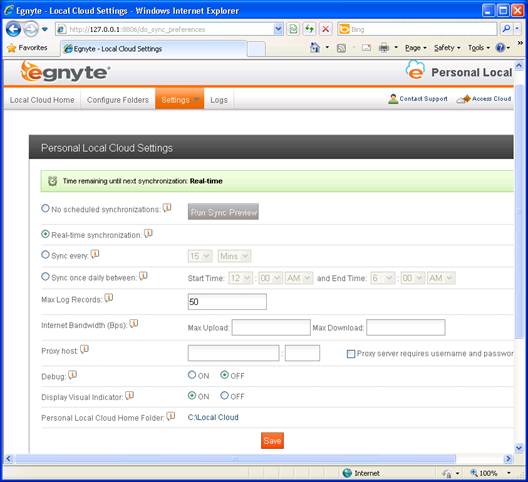
The screenshot above shows Egnyte can sync folders in real-time or scheduled times; however, it is also clear that it supports only one sync task. So it cannot create multiple sync tasks, nor can it set multiple sync schedules.
While Egnyte can selectively sync folders in the cloud, the local sync-ed folders must be a special folder. In this case "C:\local cloud". The local folder cannot be changed!
Moreover, Egnyte Local Cloud clearly does not support client-side encryption as there is no place to enter/select an encryption key.

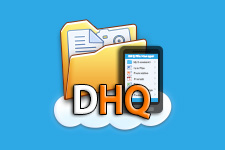










Leave a Comment